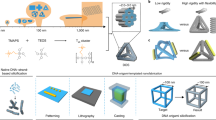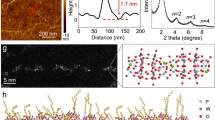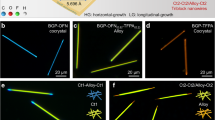Abstract
There has been growing interest in the past decade in one-dimensional (1D) nanostructures, such as nanowires, nanotubes or nanorods, owing to their size-dependent optical and electronic properties and their potential application as building blocks, interconnects and functional components for assembling nanodevices1,2. Significant progress has been made; however, the strict control of the distinctive geometry at extremely small size for 1D structures remains a great challenge in this field. The anisotropic nature of cylindrical polymer brushes has been applied to template 1D nanostructured materials, such as metal, semiconductor or magnetic nanowires3,4,5,6. Here, by constructing the cylindrical polymer brushes themselves with a precursor-containing monomer, we successfully synthesized hybrid nanowires with a silsesquioxane core and a shell made up from oligo(ethylene glycol) methacrylate units, which are soluble in water and many organic solvents. The length and diameter of these rigid wires are tunable by the degrees of polymerization of both the backbone and the side chain. They show lyotropic liquid-crystalline behaviour and can be pyrolysed to silica nanowires. This approach provides a route to the controlled fabrication of inorganic or hybrid silica nanostructures by living polymerization techniques.
This is a preview of subscription content, access via your institution
Access options
Subscribe to this journal
Receive 12 print issues and online access
$259.00 per year
only $21.58 per issue
Buy this article
- Purchase on Springer Link
- Instant access to full article PDF
Prices may be subject to local taxes which are calculated during checkout





Similar content being viewed by others
References
Johnson, J. C. et al. Single gallium nitride nanowire lasers. Nature Mater. 1, 106–110 (2002).
Wang, Z. L. & Song, J. Piezoelectric nanogenerators based on zinc oxide nanowire arrays. Science 312, 242–246 (2006).
Djalali, R., Li, S.-Y. & Schmidt, M. Amphipolar core–shell cylindrical brushes as templates for the formation of gold clusters and nanowires. Macromolecules 35, 4282–4288 (2002).
Zhang, M., Estournes, C., Bietsch, W. & Müller, A. H. E. Superparamagnetic hybrid nanocylinders. Adv. Funct. Mater. 14, 871–882 (2004).
Zhang, M., Drechsler, M. & Müller, A. H. E. Template-controlled synthesis of wire-like cadmium sulfide nanoparticle assemblies within core–shell cylindrical polymer brushes. Chem. Mater. 16, 537–543 (2004).
Yuan, J., Drechsler, M., Xu, Y., Zhang, M. & Müller, A. H. E. Cadmium selenide nanowires within core–shell cylindrical polymer brushes: Synthesis, characterization and the twice loading process. Polymer 49, 1547–1554 (2008).
Duan, X. & Lieber, C. M. General synthesis of compound semiconductor nanowires. Adv. Mater. 12, 298–302 (2000).
Ma, C. & Wang, Z. L. Road map for the controlled synthesis of CdSe nanowires, nanobelts, and nanosaws-a step towards nanomanufacturing. Adv. Mater. 17, 2635–2639 (2005).
Grebinski, J. W., Richter, K. L., Zhang, J., Kosel, T. H. & Kuno, M. Synthesis and characterization of Au/Bi core/shell nanocrystals: A precursor toward II–VI nanowires. J. Phys. Chem. B 108, 9745–9751 (2004).
Adelung, R. et al. Strain-controlled growth of nanowires within thin-film cracks. Nature Mater. 3, 375–379 (2004).
Milenkovic, S., Hassel, A. W. & Schneider, A. Effect of the growth conditions on the spatial features of Re nanowires produced by directional solidification. Nano Lett. 6, 794–799 (2006).
Zhang, M. & Müller, A. H. E. Cylindrical polymer brushes. J. Polym. Sci. A 43, 3461–3481 (2005).
Dziezok, P., Sheiko, S. S., Fischer, K., Schmidt, M. & Möller, M. Cylindrical molecular brushes. Angew. Chem. Int. Ed. 36, 2812–2815 (1998).
Berdyyeva, T., Woodworth, C. D. & Sokolov, I. Visualization of cytoskeletal elements by the atomic force microscope. Ultramicroscopy 102, 189–198 (2005).
Stöber, W., Fink, A. & Bohn, E. Controlled growth of monodisperse silica spheres in the micron size range. J. Colloid Interface Sci. 26, 62–69 (1968).
Wang, X. et al. Cylindrical block copolymer micelles and co-micelles of controlled length and architecture. Science 317, 644–647 (2007).
Wang, X. et al. Shell-cross-linked cylindrical polyisoprene-b-polyferrocenylsilane (PI-b-PFS) block copolymer micelles: One-dimensional (1D) organometallic nanocylinders. J. Am. Chem. Soc. 129, 5630–5639 (2007).
Zollfrank, C., Scheel, H. & Greil, P. Regioselectively ordered silica nanotubes by molecular templating. Adv. Mater. 19, 984–987 (2007).
Ren, L. & Wark, M. Controlled growth of Pt-containing SiO2 nanotubes with high aspect ratios. Chem. Mater. 17, 5928–5934 (2005).
Park, J. W. & Thomas, E. L. A surface-reactive rod-coil diblock copolymer: Nano- and micropatterned polymer brushes. J. Am. Chem. Soc. 124, 514–515 (2002).
Wei, H. et al. Synthesis and applications of shell cross-linked thermoresponsive hybrid micelles based on poly(N-isopropylacrylamide-co-3-(trimethoxysilyl)propyl methacrylate)-b-poly(methyl methacrylate). Langmuir 24, 4564–4570 (2008).
Hermanson, K. O., Lumsdon, S. O., Williams, J. P., Kater, E. W. & Velev, O. D. Dielectrophoretic assembly of electrically functional microwires from nanoparticle suspensions. Science 294, 1082–1086 (2001).
Huang, Y., Duan, X., Wei, Q. & Lieber, C. M. Directed assembly of one-dimensional nanostructures into functional networks. Science 291, 630–633 (2001).
Elbahri, M., Paretkar, D., Hirmas, K., Jebril, S. & Adelung, R. Anti-lotus effect for nanostructuring at the leidenfrost temperature. Adv. Mater. 19, 1262–1266 (2007).
van der Schoot, P. The hexagonal phase of wormlike micelles. J. Chem. Phys. 104, 1130–1139 (1996).
Wintermantel, M. et al. Lyotropic phases formed by ‘molecular bottlebrushes’. Angew. Chem. Int. Ed. 34, 1472–1474 (1995).
Li, L.-S. & Alivisatos, A. P. Semiconductor nanorod liquid crystals and their assembly on a substrate. Adv. Mater. 15, 408–411 (2003).
Li, L.-S., Walda, J., Manna, L. & Alivisatos, A. P. Semiconductor nanorod liquid crystals. Nano Lett. 2, 557–560 (2002).
Zhang, M., Breiner, T., Mori, H. & Müller, A. H. E. Amphiphilic cylindrical brushes with poly(acrylic acid) core and poly(n-butyl acrylate) shell and narrow length distribution. Polymer 44, 1449–1458 (2003).
Acknowledgements
This work was supported by the Deutsche Forschungsgemeinschaft (grant Mu896/22). We thank M. Drechsler, V. Olszowka, M. Hund, B. Goßler, C. Löffler, and J. Crassous for their help in TEM, AFM, SEM, TGA and polarized optical microscopy measurements. We also thank G. Lattermann for the helpful discussions on polarized optical microscopy.
Author information
Authors and Affiliations
Corresponding author
Supplementary information
Supplementary Information
Supplementary Figures S1–S3 (PDF 91 kb)
Rights and permissions
About this article
Cite this article
Yuan, J., Xu, Y., Walther, A. et al. Water-soluble organo-silica hybrid nanowires. Nature Mater 7, 718–722 (2008). https://doi.org/10.1038/nmat2232
Received:
Accepted:
Published:
Issue Date:
DOI: https://doi.org/10.1038/nmat2232
This article is cited by
-
Controllably Growing Topologies in One-shot RAFT Polymerization via Macro-latent Monomer Strategy
Chinese Journal of Polymer Science (2021)
-
Limited Fraction of Crystallized Side Chains in Bottlebrush Poly(n-alkyl methacrylate)s
Chinese Journal of Polymer Science (2021)
-
Synthesis and applications of anisotropic nanoparticles with precisely defined dimensions
Nature Reviews Chemistry (2020)
-
Aggregation shapes of amphiphilic ring polymers: from spherical to toroidal micelles
Colloid and Polymer Science (2020)
-
Synthesis and Characterization of a Liquid Crystalline Polyferrocenylsilane Brush
Journal of Inorganic and Organometallic Polymers and Materials (2015)



